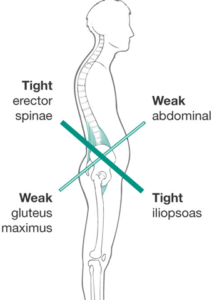You are in a time pinch and you feel tight. You have been sitting all day at your desk, what can you do quickly to loose up?
My favorite exercise to do after prolonged sitting is “The Couch Stretch”. When we sit for long periods of time with our hips in a shortened position this shortens muscles in the front of our hip and thigh and can cause knee, hip, and back pain.
Remember this posture from last week.

In this posture we have a short and tight low back and hip flexors. We want to correct our pelvic position when doing any exercise to a neutral pelvic position, so we will cue squeezing our glutes (butt) and tucking our tailbone to create the stretch in the right place.
This stretch can be very intense especially if you run on the stiffer side. Do not force it and focus on proper posture. If it is painful or feels like your muscles are tearing, you are stretching too hard. Start with 2 sets of ten and if tolerated increase frequency. Research supports that in order to truly change tissue length we need 100 repetitions for approximately 6 weeks.
Initial changes in range of motion when beginning stretching programs are due to changes in tolerance to stretch and not tissue length. Longer term stretching and proper strengthening and rehabilitative exercises will ensure long term changes in tissue length/range of motion, overall health, and performance.
Things to watch out for while doing the couch stretch:
- Arching of your back- “tuck you tailbone”
- Shifting of your body weight
- Keep your pelvis/hips level. One side should not be higher or more rotated than the other
- Start slow, don’t rush into it. Your body may not be ready for this one, so you might start first with the chair stretch or even just a traditional quad stretch or hip flexor stretch.
A rare complaint during this stretch is knee, back, or hip pain. If you are experiencing this don’t perform the stretch and seek out further evaluation from a professional. Remember if something feels tight or painful and stretching doesn’t help, something else is going on. The tightness/pain you are feeling might be the body’s protective mechanism for instability around the joint, arthritis, soft tissue damage, and many others.
Have a great week and please feel free to contact us with any questions.
Dr. Ryan Dunn D.C.
